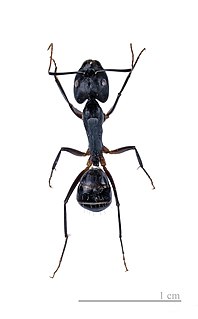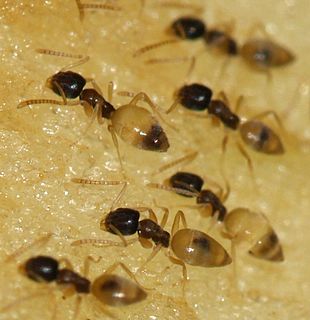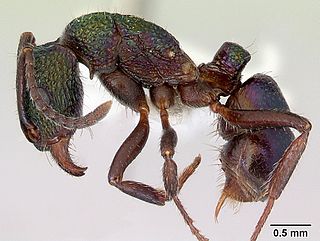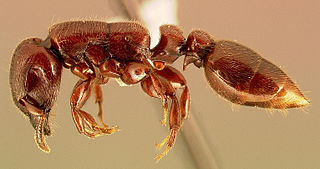
The Formicinae are a subfamily within the Formicidae containing ants of moderate evolutionary development.

Dolichoderinae is a subfamily of ants, which includes species such as the Argentine ant, the erratic ant, the odorous house ant, and the cone ant. The subfamily presents a great diversity of species throughout the world, distributed in different biogeographic regions, from the Palearctic, Nearctic, Afrotropical region and Malaysia, to the Middle East, Australian, and Neotropical regions.

Tapinoma is a genus of ants that belongs to the subfamily Dolichoderinae. The genus currently comprises 74 described species distributed worldwide in tropical and temperate regions. Members of are generalized foragers, nesting in a wide variety of habitats, ranging from grasslands, open fields, woodlands, to inside buildings. The majority of species nest in the ground under objects such as stones or tree logs, other species build nests under bark of logs and stumps, in plant cavities, insect galls or refuse piles.

Doleromyrma is a genus of ants in the subfamily Dolichoderinae. The genus is native to Australia, where the ants nest in soil, or under stones or logs.

Plagiolepis is an ant genus of the formic acid-producing subfamily Formicinae. The genus is found in tropical and temperate regions of the Old World.
John S. Clark was a Scottish-born Australian entomologist and myrmecologist known for his study of Australian ants. Born in Glasgow, he developed an interest in entomology at a young age. Clark first arrived in Australia in 1905 and originally worked for the state railways in Queensland. He developed an interest in ants shortly afterwards, collecting his first specimens in North Queensland. He married his first wife, Maggie Forbes in 1908, bearing four children, until her death in 1935. He married his second wife, Phyllis Marjorie Claringbulls in 1939 and had two daughters with her until she committed suicide in 1943. As a result, Clark sent his daughters to an orphanage.

Hypoponera is a genus of ants in the subfamily Ponerinae. The genus has a worldwide distribution and is found in all continents except Antarctica.

Rhytidoponera is a large genus of ants in the subfamily Ectatomminae. The genus is known from Australia and Melanesia, with New Caledonia as the most eastern limit.

Stigmatomma is a genus of ants in the subfamily Amblyoponinae. The genus has a worldwide distribution, and like most other amblyoponines, Stigmatomma species are specialized predators. First described by Roger (1859), it was for a long time considered to be a synonym of Amblyopone until it was revived as an independent genus by Yoshimura & Fisher (2012) based on worker mandible morphology.

Cerapachys is a genus of ants in the subfamily Dorylinae. Species are mainly myrmecophagous ants which raid the nests of other ants for prey. The genus is distributed widely throughout the tropical and subtropical regions of the world, with the majority of species known from the Indo-Australian region.

Colobostruma is a genus of ants in the subfamily Myrmicinae. All except one species are restricted to Australia. The only non-Australian species, C. foliacea, is found in New Guinea and the Solomon Islands.

Podomyrma is a genus of ants in the subfamily Myrmicinae.

Meranoplus is an Old World genus of ants in the subfamily Myrmicinae. With over 80 valid species, it is predicted that over half of the Meranoplus diversity remains undescribed, most of these from Australia.

Metapone is an Old World genus of ants in the subfamily Myrmicinae. The genus is found in the Indo-Australian, Oriental and Malagasy regions. Most species are known only from a few specimens.

Melophorus is a genus of ants in the subfamily Formicinae and the sole member of the tribe Melophorini. The genus is endemic to Australia, where its species are common in arid and semiarid areas.

Stigmacros is an Australian genus of small ants in the subfamily Formicinae. The genus is endemic to Australia. They are generalist predators that forage in the leaf litter, on the ground or in trees.

Notoncus is an Australian genus of ants in the subfamily Formicinae. The genus is known from Australia, where the ants nest in the soil or on the ground under stones and logs in forested areas. The ants are also common in gardens and parks.

Pseudolasius is a genus of ants in the subfamily Formicinae. The genus is known from southern Asia to northern Australia, where it appears to be restricted to tropical areas.



















